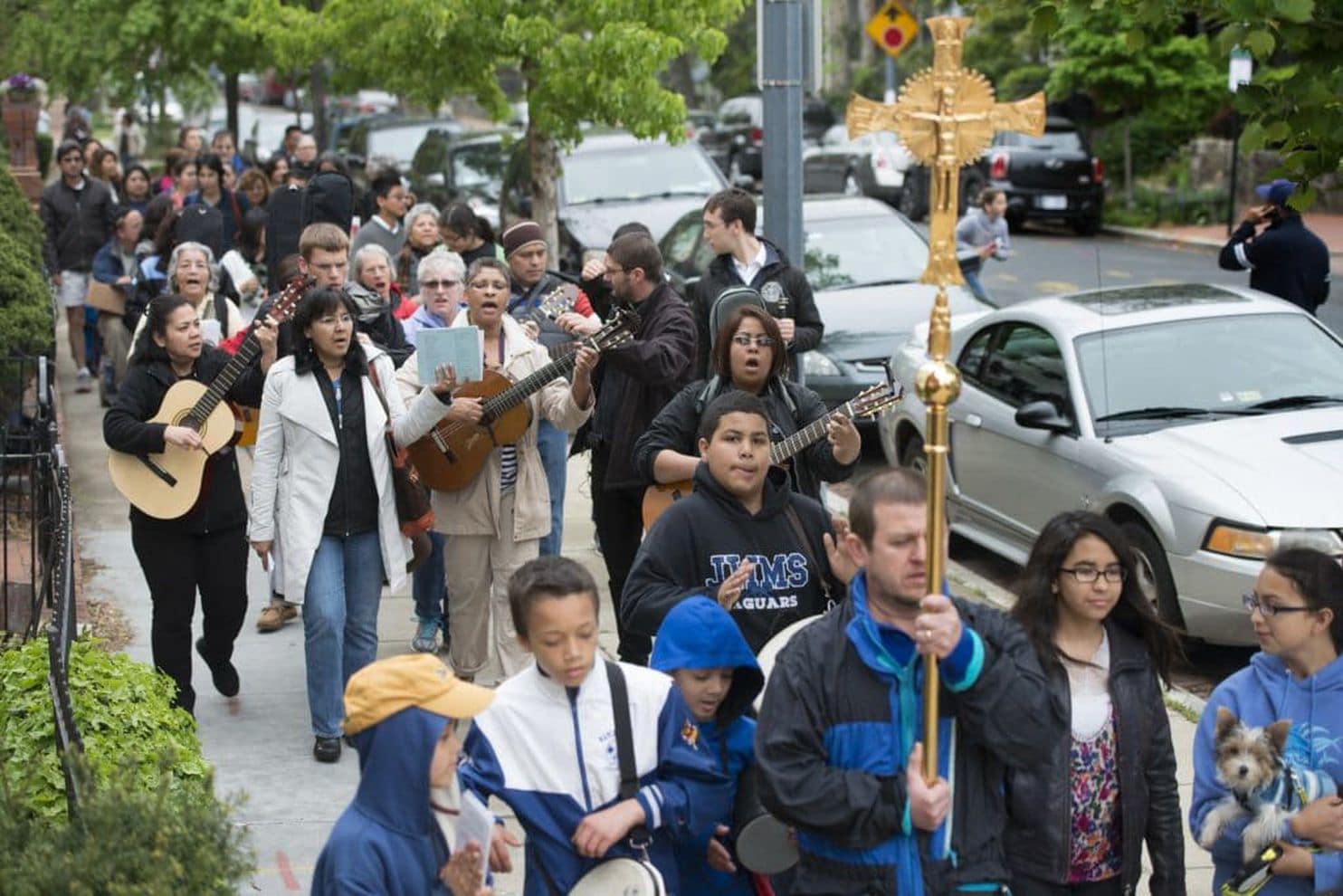Acts of Faith
Fishing for another ‘like’: At Easter, many Christians return to door-to-door methods.
EMAIL THE AUTHOR

Members of a Catholic church are seen evangelizing in Washington, D.C. (Marvin Joseph/The Washington Post)
Like many a modern evangelist, the Rev. Cornel Dunmore often starts his days on Facebook.
Online, Dunmore checks his every metric. He knows how many people will come to Easter breakfast if they see a Facebook ad, what sort of people his Twitter feeds can reach, and who responds to texts, email blasts and surveys. He can reach the masses in minutes — and, he hopes, lead them one step closer to Jesus.
So why, two weeks before Easter, did he tell the members of his church in Southeast Washington that each one of them should walk out the door after the service and approach strangers about coming to church — not online, efficiently, but one by one, face to face?
“Every born-again Christian ought to know how,” he said. “We can’t be sitting in a pew. At some point, we’ve got to go somewhere, to somebody else, and share our Christian faith.”
Easter seems to bring out the impulse to share the word more than any other holiday in the Christian calendar.
The focus on Jesus’ resurrection from the grave offers the promise of renewed life and salvation from sin — a fitting message to share with people who perhaps have been away from church for a long time and could be persuaded to come back.
And maybe it has something to do with the changing of the seasons, as Easter tends to arrive just as springtime beckons people outdoors again (at least, when the weather cooperates).
“For churches, Easter is the Super Bowl of the Christian year,” said Ed Stetzer, an expert on evangelism at Wheaton College in Illinois. “People who don’t normally come, come. And people bring their friends. I think there’s an openness now that people don’t see other times of the year.”
He added, “It’s not just Christianity. High holy days of religion are when nominal people of that faith try to reconnect. It’s one of the reasons to be so intentionally evangelistic.”
Stetzer gave a how-to talk on Palm Sunday at Saddleback Church in Orange County, Calif., one of the nation’s largest megachurches, about best practices for approaching neighbors to invite them to Easter services. “If you really think that on Friday a guy was dead, and on Sunday he was back, there is a certain obligation to go out and share it,” he said. “All the opportunities that people have, they should take. I’m one who thinks it’s a natural thing that people of faith would tell other people — they’re going door to door, inviting friends to Easter.”
Doorbells across the Washington region were ringing this past week, thanks to the efforts of amateur evangelists from diverse denominations.
In Fairfax County, members of Springfield’s Summit Church fanned out to such public gathering spots as grocery stores and handed out free Russell Stover chocolate crosses to passersby with invitations to come to the church’s four Easter Sunday “experiences.”
In Silver Spring, the Misión San Andrés went door to door. Other Catholic churches, through the Washington and Arlington dioceses’ “The Light Is On” campaign, encouraged lapsed Catholics to return at Easter in a variety of ways: open hours for personal prayer during Lent, stations of the cross processions, concerts, speakers and more.
St. Dominic’s parish used a U.S. Postal Service direct-mail program to send invitations to church to every mailbox in Southwest Washington — about 8,000 mailings, the Washington Archdiocese said. Several Protestant churches used similar targeted blasts.
Dunmore said he first learned about person-to-person evangelism when he attended an Evangelism Explosion program at Barcroft Bible Church in Fairfax, VA that taught him strategies for outreach. He came home feeling that historically black churches, like Anacostia’s Revival Temple Church, where he was a youth minister at the time, weren’t evangelizing like their predominantly white counterparts.
So he started his own ministry to teach churches how to evangelize. Two years ago, he founded a church, Catch of the Day DC, which meets in a community center on the grounds of St. Elizabeths Hospital.
Every member at Catch of the Day DC goes through Dunmore’s evangelism course. The requirements are strict. There are tests about the church’s creed and the impact of interpersonal interactions, which a new evangelist must pass with at least an 80 percent score. There’s a pledge to immediately tell one person about Jesus.
And based on Jesus’ promise that he would make his disciples “fishers of men,” every element of Dunmore’s training comes with a fishing metaphor. “We do some modern and sophisticated techniques to catch fish. We’re not just knocking on doors,” said Dunmore, who saw 130 people register for his Easter seafood breakfast — which was only meant to host 50 people — because his efforts were so quickly successful. “In our mind, it’s all like a bite on the line. … Somebody just bit the line: Somebody’s coming to the breakfast. Somebody’s coming to church. And just maybe, somebody’s going to come to know Jesus as their personal lord and savior. That is the goal.”
The Mormon Church is among the most sophisticated online evangelists out there — just visit Mormon.org once, and you’ll probably see targeted ads directing you back to the site on your Internet browser for days. But the church is also one of the most devoted to old-school, door-to-door tactics. Jacob Criddle and Evan Stolk, who are serving their two-year mission for the Church of Jesus Christ of Latter-day Saints in the Washington area, spend most of their days ringing doorbell after doorbell, from 10 a.m. to 9 p.m.
“I don’t think anything can ever replace a face-to-face testimony of what Jesus Christ did for us,” said Criddle, 20, as he and Stolk, 21, walked a route through a residential neighborhood near Catholic University last week.
Every time someone answered a door, or hurried past walking a dog, the young men called out, tailoring their usual message to the holiday season. “We’re sharing a message with people this Easter season about Jesus Christ and what he’s done for us.” “Do you have 30 seconds to watch a quick Easter video our church puts out every year?”
Almost everyone turned the missionaries away. But when they encountered a postal carrier delivering the mail, she didn’t.
“Lately I’ve been feeling like my faith has been tested a lot. I feel like you’re a messenger. He might have sent you right at the time that I need,” she said. She turned away, and when she faced them again, tears were running down her face. “It’s been really challenging today.”
Later, the carrier — who didn’t want her name published — said that she was upset that day over an argument she’d had. And she’s been worn down for a long time by the demands of being a single mother and of her job. Singing in the choir in her Baptist church used to help, but she hasn’t been able to attend in the two years since she started her job for the Postal Service, which includes shifts every Sunday. “I really miss it,” she said of her church.
Now, as she cried, Criddle said to her gently, “I know that it’s not a coincidence that we’re here today,” and she agreed. “It don’t feel like it.”
“We truly are representatives of the Lord Jesus Christ,” Stolk said. “The things that we share with people bring them peace, true peace.”
“That’s what I need in my life,” she said. They set up a time to talk later, when she had a day off. Just in time for Easter.
Tap The Washington Post for the original story.
